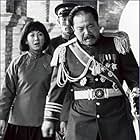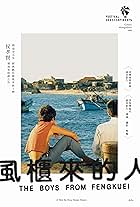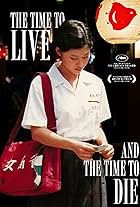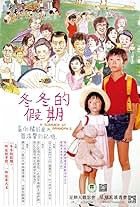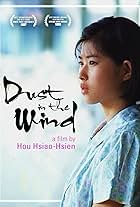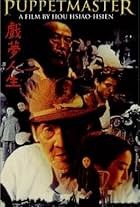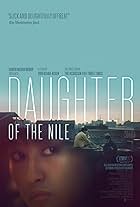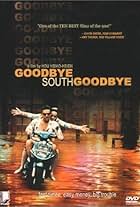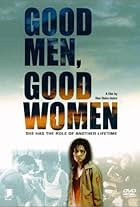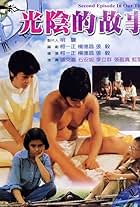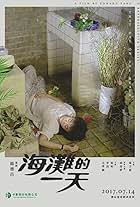IMDb RATING
7.1/10
800
YOUR RATING
Three vignettes from three different directors that tell stories of ordinary people during Taiwan's Cold War period.Three vignettes from three different directors that tell stories of ordinary people during Taiwan's Cold War period.Three vignettes from three different directors that tell stories of ordinary people during Taiwan's Cold War period.
- Awards
- 3 nominations
Photos
Cheng-Kuo Yen
- Chiang A-jih (segment "The Taste of Apple")
- (as Jing-Kuo Yan)
- Directors
- Writers
- All cast & crew
- Production, box office & more at IMDbPro
Storyline
Did you know
- GoofsThe first short film is set in 1962. When the protagonist rides the tricycle he promotes loudly the Taiwanese movie _Wo nu ruo lan (1966)_ (Orchids and My Love), which was released in 1966.
- ConnectionsFeatured in Flowers of Taipei: Taiwan New Cinema (2014)
Featured review
The New Taiwanese Cinema movement started with 'In our Time(1982)' an anthology film with four short films by pioneers of Taiwanese new wave depicting the lives and struggles of the common folk of the newly independant and growing Taiwan with the progress of the country shown from 1950 to the 1980 in different segments by four Extraordinarily directors Edward Yang, Tao Te-che, Ko I-chen and Yi chang ; who will change the face of Taiwanese cinema from kung-fu movies and rom-coms to more serious films portraying the birth of a new Nation.
The first segemt portrays an innocent childhood, the second a curious and confused adolescent, the third a charming college student and fourth athe everyday struggles of a new relationship. They are all very funny especially the last segment and brings a great smile on your face.
With Similar theme and structure another anthology film consisting of three short films by three new talented directors depicting the economic development of the new country during the 'Cold War' period with aid from the United States of America called the 'The Sandwich Man(1983)' came out and it is regarded as a milestone in the new cinema movement and helped curate it into a country wide phenomenon.
1) The first story called "Son's big Doll" by Hou Hsiao-hsien ( credited as 'Hou Saou-Shan' in it) tells the story of a man who wanders around the town in a clown outfit, advertising movies for a cinema after pitching this idea to his boss after reading in the newspaper of a similar man in Japan who used the same concept to aid his business. For Just NT350 his boss agrees to his idea rather reluctantly.
His Uncle does not support his new venture but being an uneducated man this is the only job he could think of to support his wife and a new born child. After some time when his boss asks him to stop roaming around like a clown and ride a rickshaw instead he happily agrees but is conflicted when his son refuses to identify him without the clown makeup.
2) The second Story called "Vick's Hat" by Tsang Jong-Cheung tells us the story of two ambitious young salesmen, one of those who was in the army ; who sell pressure cookers for a Japanese company by going different places in their truck and bikes to sell the product to the local public who had never heard of such product which can cook their food which usually takes two hours in ten minutes.
The public thinks of the product to be too good to be true and when the young men are not able to sell their target they decide to go separately on different bikes, to cover more area and start demonstrating the product to gain the confidence of the people ; only to discover late that the product they are selling is defective and will hurt one of them severly when it will explode during a demonstration, leading the other to condemn the company and curse it.
3) The third story called " The Taste of Apples" by Jen Wan tells us the story of a poor man that has been hit by the car of an high ranking American embassy official, when he is going for finding labour, that breaks his legs.
The poor man has a family of 6 with 5 children and a wife, due to his low income and nature of the labouring job his family is not in a good state, they live in one the the last remaining slum districts soon to be converted into high rise apartments. Of the 5 children one is a new born, one girl his mute and of the three that go to school none of them are able to afford the fees and are regularly humilated in front of the class to submit the fees.
The accident comes as a blessing in disguise for the family as the embassy takes the responsibility to treat him in their own luxurious white hospital and the Official pledges to look after his family and treatment by providing ample money satrting with NT50,000 ; an amount it would take years for him to earn by doing labour.
His wife is happy that now they will be able to look after thier kids better and pay their fees and pay their expenses, while the kids are excited when they sit in the luxurious car of the American Official and show off in front of their friends.
Also in the hospital, the family tastes apples for the first time in their life and eat them with a smile of sweetness. The story ends with the a framed photo of the family hanging on a wall where everybody is dressed in new clothes and are looking happy.
These movies spanning from (1962- 1969), despite their minimalistic approach, portrayed the true feelings of the whole nation and put forward their struggles to different people throughout the world by participating and winning numerous film festivals and awards and somewhat helped put Taiwan on the world map, allowing many nations to recognise and aid this newly independant nation, which will eventually become one of the most advanced countries in the world in just a matter of decades, excellencing in various fields.
Edward Yang and Hou Hsiao-hsien will go on to make some of the most remarkable movies for not only taiwan but also world cinema like yang's magnum opus ' A brighter Summer day', ' Taipei Story', 'Yi-Yi', 'That day, on the beach', 'Mahjong' etc and Hou Hsiao-hsien making ' A city of Sadness', 'Flowers of Shanghai', ' Dust in the wind', ' Time to live and time to die', 'The boys from Fengkuei', 'The Puppetmaster' etc just to name a few.
Their movement will eventually lead to the world discovering new talents like 'Ang Lee', 'Sylvia Chang', Stan Lai' etc. Who will help in reviving the forgotten genres of cinema of taiwan and help expanding it greatly in the world, with ang lee becoming one of the most recognised directors in the world.
The first segemt portrays an innocent childhood, the second a curious and confused adolescent, the third a charming college student and fourth athe everyday struggles of a new relationship. They are all very funny especially the last segment and brings a great smile on your face.
With Similar theme and structure another anthology film consisting of three short films by three new talented directors depicting the economic development of the new country during the 'Cold War' period with aid from the United States of America called the 'The Sandwich Man(1983)' came out and it is regarded as a milestone in the new cinema movement and helped curate it into a country wide phenomenon.
1) The first story called "Son's big Doll" by Hou Hsiao-hsien ( credited as 'Hou Saou-Shan' in it) tells the story of a man who wanders around the town in a clown outfit, advertising movies for a cinema after pitching this idea to his boss after reading in the newspaper of a similar man in Japan who used the same concept to aid his business. For Just NT350 his boss agrees to his idea rather reluctantly.
His Uncle does not support his new venture but being an uneducated man this is the only job he could think of to support his wife and a new born child. After some time when his boss asks him to stop roaming around like a clown and ride a rickshaw instead he happily agrees but is conflicted when his son refuses to identify him without the clown makeup.
2) The second Story called "Vick's Hat" by Tsang Jong-Cheung tells us the story of two ambitious young salesmen, one of those who was in the army ; who sell pressure cookers for a Japanese company by going different places in their truck and bikes to sell the product to the local public who had never heard of such product which can cook their food which usually takes two hours in ten minutes.
The public thinks of the product to be too good to be true and when the young men are not able to sell their target they decide to go separately on different bikes, to cover more area and start demonstrating the product to gain the confidence of the people ; only to discover late that the product they are selling is defective and will hurt one of them severly when it will explode during a demonstration, leading the other to condemn the company and curse it.
3) The third story called " The Taste of Apples" by Jen Wan tells us the story of a poor man that has been hit by the car of an high ranking American embassy official, when he is going for finding labour, that breaks his legs.
The poor man has a family of 6 with 5 children and a wife, due to his low income and nature of the labouring job his family is not in a good state, they live in one the the last remaining slum districts soon to be converted into high rise apartments. Of the 5 children one is a new born, one girl his mute and of the three that go to school none of them are able to afford the fees and are regularly humilated in front of the class to submit the fees.
The accident comes as a blessing in disguise for the family as the embassy takes the responsibility to treat him in their own luxurious white hospital and the Official pledges to look after his family and treatment by providing ample money satrting with NT50,000 ; an amount it would take years for him to earn by doing labour.
His wife is happy that now they will be able to look after thier kids better and pay their fees and pay their expenses, while the kids are excited when they sit in the luxurious car of the American Official and show off in front of their friends.
Also in the hospital, the family tastes apples for the first time in their life and eat them with a smile of sweetness. The story ends with the a framed photo of the family hanging on a wall where everybody is dressed in new clothes and are looking happy.
These movies spanning from (1962- 1969), despite their minimalistic approach, portrayed the true feelings of the whole nation and put forward their struggles to different people throughout the world by participating and winning numerous film festivals and awards and somewhat helped put Taiwan on the world map, allowing many nations to recognise and aid this newly independant nation, which will eventually become one of the most advanced countries in the world in just a matter of decades, excellencing in various fields.
Edward Yang and Hou Hsiao-hsien will go on to make some of the most remarkable movies for not only taiwan but also world cinema like yang's magnum opus ' A brighter Summer day', ' Taipei Story', 'Yi-Yi', 'That day, on the beach', 'Mahjong' etc and Hou Hsiao-hsien making ' A city of Sadness', 'Flowers of Shanghai', ' Dust in the wind', ' Time to live and time to die', 'The boys from Fengkuei', 'The Puppetmaster' etc just to name a few.
Their movement will eventually lead to the world discovering new talents like 'Ang Lee', 'Sylvia Chang', Stan Lai' etc. Who will help in reviving the forgotten genres of cinema of taiwan and help expanding it greatly in the world, with ang lee becoming one of the most recognised directors in the world.
- yadavanita-18093
- Aug 11, 2021
- Permalink
Details
- Release date
- Country of origin
- Languages
- Also known as
- Er zih de da wan ou
- Production companies
- See more company credits at IMDbPro
Contribute to this page
Suggest an edit or add missing content




